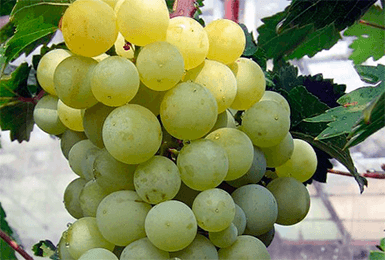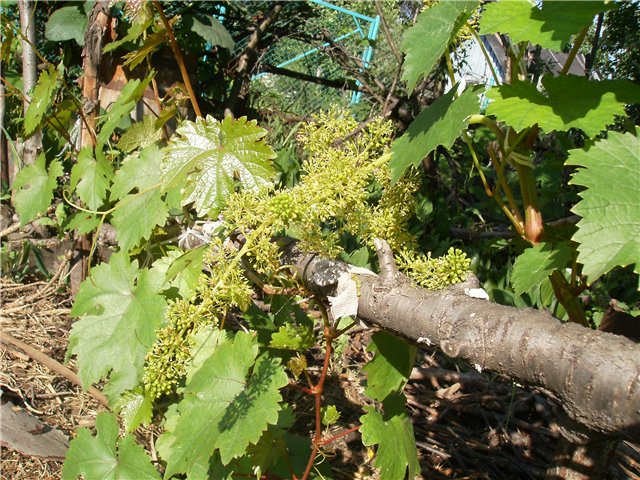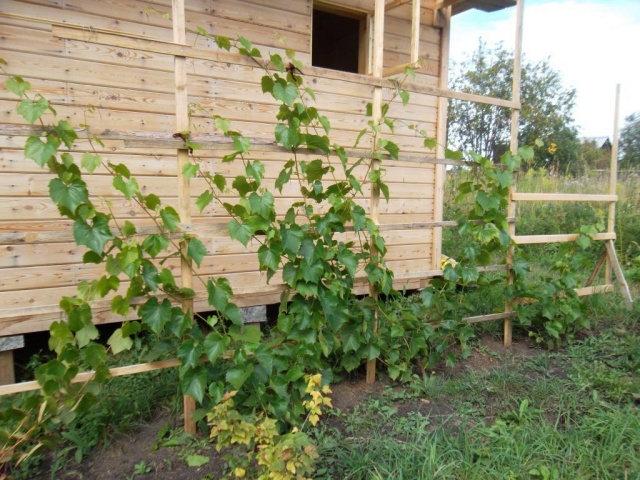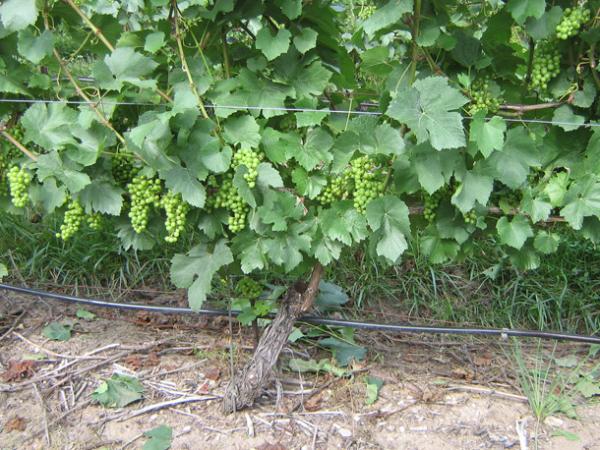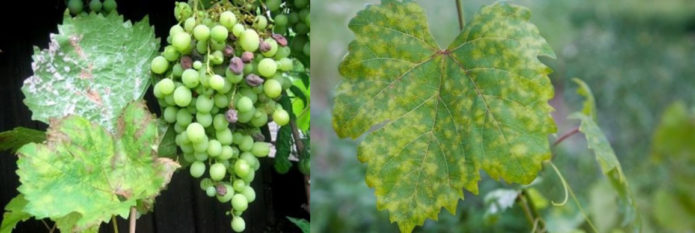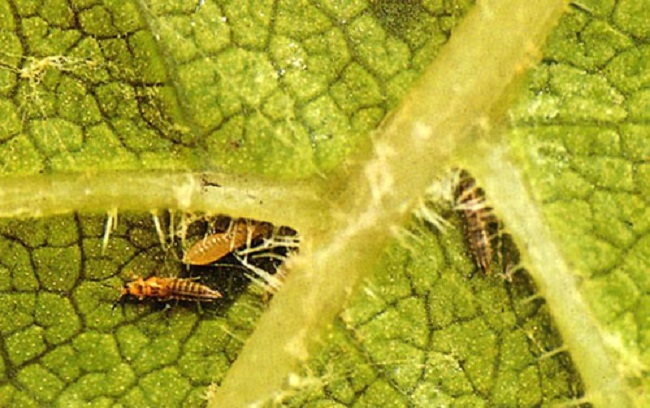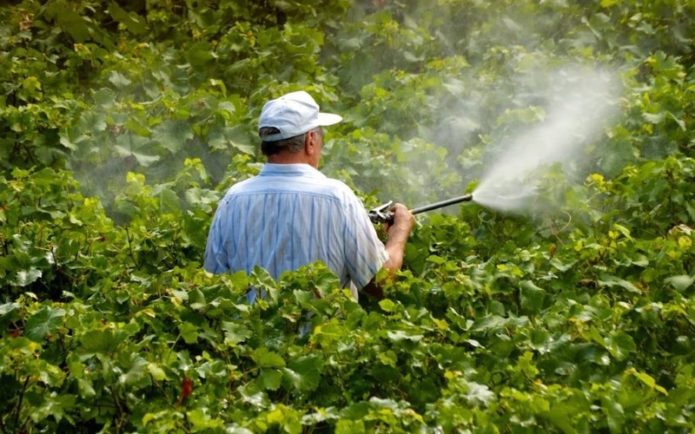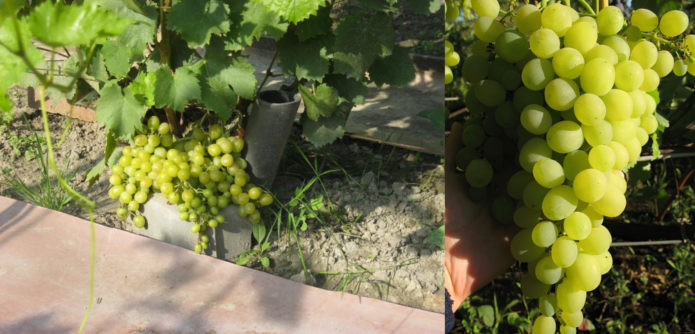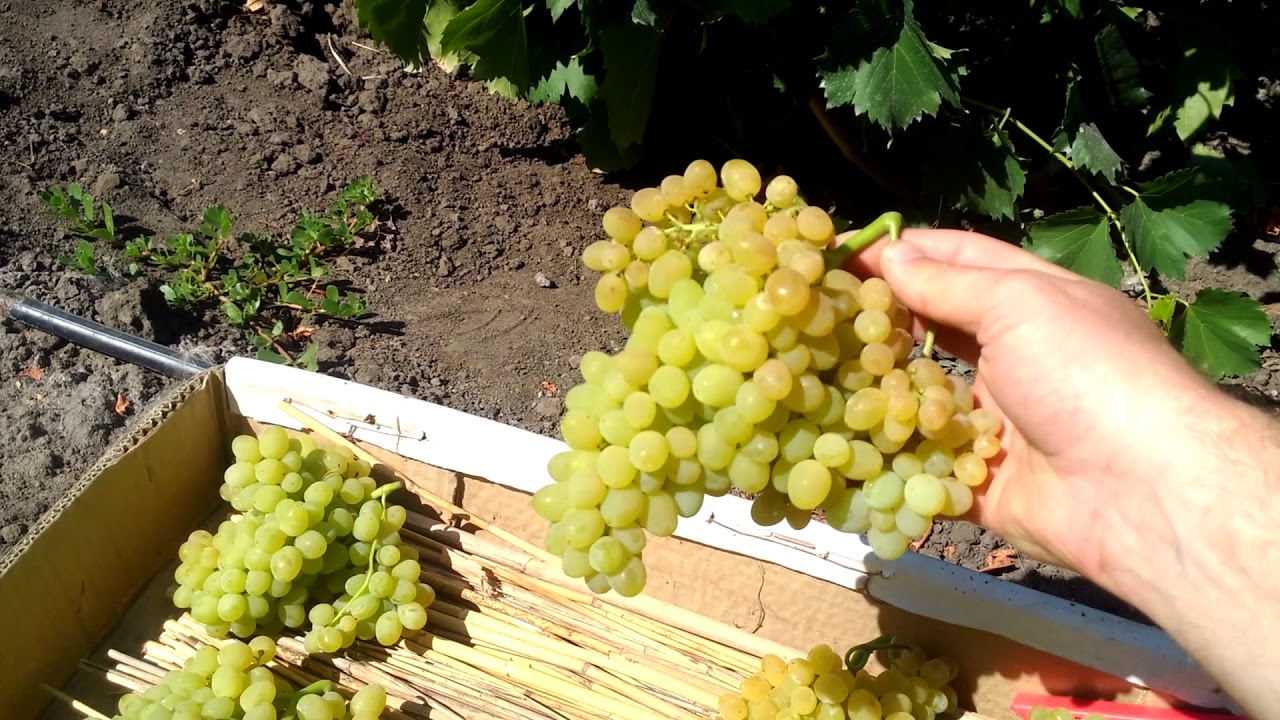Not only in the south, but also in Central Russia, Siberia, the Urals and other regions located in the zones of risky farming, gardeners are interested in growing ultra-early ripening grape varieties, which already in the middle of summer "ruddy side, fragrant juice" ask for a table ... One of these early hybrids is the Tukay dessert grape.
Content
Characteristics of the Tukay grape variety
Experienced gardeners have been successfully cultivating this frost-resistant and unpretentious hybrid for several years in the Central Black Earth Region, in the Moscow Region, Belarus and Ukraine. Tukai ripens quite well in remote corners of our country - in the northern regions, in the northwest, in Bashkiria and in Transbaikalia. Historical facts testify that the “genius” character of this table grape is based on the “parental” traits of two extraordinary varieties that have been appreciated for a long time in our country and in Europe.
The history of breeding an early maturing hybrid
The Tukai hybrid is the result of the fruitful work of the Novocherkassk breeders of the VNIIViV named after Ya. I. Potapenko, who crossed two completely different grape varieties. Central Asian mid-season Yakdona (Ak Yakdona means "one seed") with large clusters and round, light yellow, sweet, but simple-tasting berries, requiring shelter for the winter, combined with disease-resistant early ripening Muscat grapes Sabo pearls, bred in the Kuban at the end 50s of the last century. Pearls have medium-sized clusters, earlier this fruitful variety was grown on an industrial scale; it hibernates in open ground without special frost protection.
As a result, a very early hybrid Tukai was obtained, vigorous and undemanding to the soil, with a pronounced nutmeg and moderate sweetness.
Technical indicators of Tukay grapes
The early ripening dates of the Tukai variety (90–95 days) are inherited from the Pearl Sabo grapes, and the hybrid owes its tall growth (1.5–3 meters) and good ripening of the vine to Yakdone. Tukai also inherited large clusters and powerful greens from her. Cylindro-conical, slightly loose grape clusters gain an average of 800 g, some more than a kilogram.
Yellow-green, sometimes almost white (amber in full ripeness), round berries with rich nutmeg and dense skin reach 3-5 g. The pulp is moderately sweet, slightly sour, fragrant, pleasant to the taste. Sugar content in fruits - 19%, acid - 7 g / l.
- the berries of the presented hybrid form are stored for a long time;
- sit tightly on bunches and rarely crumble;
- do not crack or damage wasps.
The flowers are bisexual, which facilitates the fertilization process and does not require the proximity of pollinators.
The leaves are deep green in color with solid edges and a slightly cut center.
Characteristics of a heat-loving culture
Tukaya vine ripens by 85%. Average yield per plant is about 20 kg under favorable weather conditions. The main condition is the average daily temperature during the growing season + 20 ° C and the absence of recurrent frosts. When propagating by cuttings, the seedlings quickly take root and begin to bear fruit in the 2-3rd year.
The first harvest from a vine is obtained 95-105 days after budding... As a rule, in the south and southeast of our country, Tukay ripens earlier - mid-late July. At this time, the berries become sweet and juicy, begin to acquire a crimson color; the bunches gain weight up to 600-800 g. In the northern regions and in central Russia, this early-ripening grape is a little late with the harvest, the first ripe berries with a honey aroma can be tasted in early August, fully ripe by August 10-15. Berries of the Tukai variety are valued for the fact that they are not damaged during transportation and can retain their original shape and not deteriorate within 4–5 months from the date of cutting. Bunches of grapes are usually stored in a dry, cool room at a temperature of +6 +8 ° C. The harvest is best preserved on wooden shelves and in boxes, as well as hanging on special fasteners.
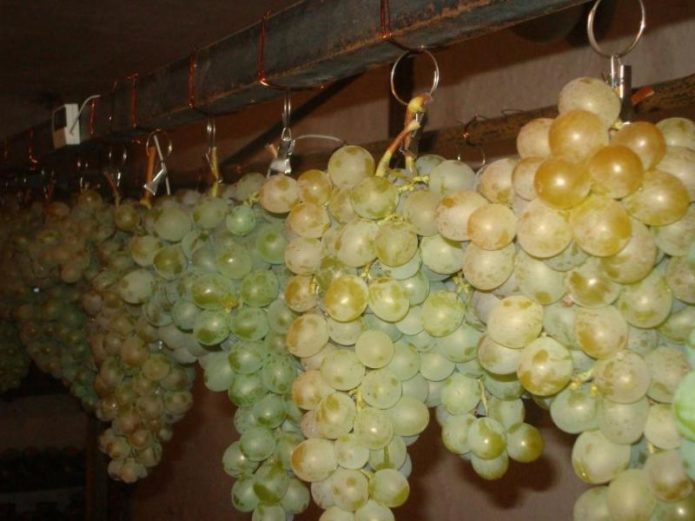
The grape vine of the Tukai hybrid retains freshness for a long time in a suspended state, subject to the humidity level and temperature in the storage
In order not to overload this variety, which cannot bear abundant fruiting, it is recommended to leave 40–45 eyes when pruning a bush, while the load on one vine should be no more than 5–7 buds (medium pruning). It is worth remembering that Tukai is capable of producing a crop from replacement buds, and with a large number of bunches, the berry becomes smaller and sour. During the growing season, be sure to remove the weak shoots and normalize the yield, leaving only 3-4 fruit clusters on one stem. A grape bush of the Tukai variety can withstand no more than 25–30 shoots.
The hybrid is not prone to overloading, since with a large number of bunches, the berry finally becomes smaller and sometimes peas. In addition, the moisture-loving culture does not tolerate dampness, since it does not have the strongest immunity to powdery mildew and powdery mildew.
It is recommended to grow a strong-growing stem of the Tukai hybrid on a two-plane trellis or a strong metal support. Tukai grapes require winter shelter when grown in Central Russia, the Urals and Siberia, despite the fact that the early maturing culture is considered winter-hardy and can withstand frosts up to + 23 ° C. In the southern regions of Russia, Tukai is rarely removed from the support, it is enough to just lower the perennial parts of the "sleeves" closer to the ground and cover them with an insulating nonwoven material.
Tukay has an average resistance to powdery mildew and other diseases, therefore, preventive treatment with fungicides is required. If the berries are damaged by wasps, the bunches are placed in mesh bags directly on the vine. This will not prevent the grapes from ripening and will keep the fruits from sweet-tooth insects, as well as from cracks and punctures.
Features of growing the grape variety Tukay
The cultivation technique of the hybrid form of Tukai is similar to other early grape varieties. If the planting hole is properly laid, there is no groundwater nearby and there are buildings nearby, the vine will be protected from cold winds in winter, and the root system will not rot and freeze during severe frosts. There are several ways of planting Tukay grapes, since an early-ripening variety is often grown in northern latitudes, in the Urals and in the Moscow region. In the event that there is a close occurrence of groundwater, it is worth paying attention to some of the features of planting a vine.
Planting the Tukai hybrid in open ground
The spring planting is started in the middle lane at the end of April, until the buds have blossomed, but the ground has already warmed up enough. In autumn, grapes are planted from early September until the first frost (until mid-October).
The presented table grape variety loves sunlight and takes root well in loam and sandy areas. Tukai is planted in a ventilated area to avoid the development of fungal diseases, provided that the plantings will warm up well and will not be affected by northern winds in winter. In the north, grapes are planted more often in the spring, in the southern regions - it takes root well in the fall. Planting can be carried out in a trench manner - in rows, or in the form of free-standing bushes.
Before planting, the roots of the grapes are soaked for a day in a solution of any growth stimulator (Epin, Zircon) prepared according to the instructions.
- If the groundwater is deeper than a meter, prepare a standard planting pit 80–90 cm deep, at the bottom of which, first of all, a bucket of clay with an admixture of black soil is poured.
- A drainage pipe, 5–7 cm in diameter, is buried here. The next layer is drainage from river gravel and branches.
- Then, peat-mixed with sand and black soil is poured into the hole - one bucket at a time. This fertile level takes up 1/3 of the planting pit, you can add 1 liter of ash, 100 g of potassium salt, 100 g of superphosphate and half a bucket of fresh horse manure.
- The grapes are lowered (2 first eyes below ground level) into a watered planting hole (2-3 buckets of settled water), straightened the roots and sprinkled with a mixture of peat and sand (layer 15-20 cm).
- From above, the trunk circle is mulched with straw or branches, needles or sawdust, this saves from drought in the hot season.
- After planting, a young seedling is tied up and pruned into 2-3 leaves.

The planting hole for grapes should be spacious, since the roots of the vine grow not only downwards, but also to the sides
It is worth considering that Tukay does not tolerate waterlogging, which oversaturates the soil with salts and lime. On swampy and saline soil, it is impossible to get a good harvest from this hybrid, unless all measures are taken to reduce soil moisture. When it is planned to plant grapes in an area with closely located groundwater, and in spring the planting site is often flooded, it is necessary to prevent unfavorable conditions for the cultivation of early Tukay grapes.
- A trench or a small pit in the form of a lake is dug around the vineyard to drain water.
- They try to plant the vine on high embankment hills and ridges, up to half a meter wide and 0.6-0.8 m high. Surface (dew) roots will remain in the upper soil layer (at a depth of 15-20 cm), the central root will go deep through water (more than 0.5 m).
- The planting hole must have a drainage layer of at least 20-30 cm.
When the water is close to water, shelter for the winter is carried out only in a dry way, so that the vineyard does not vanish and does not die from freezing of the root system. First, a layer of sand or peat is poured in the form of a mound, then spruce branches or non-woven fabric and, last of all, arcs covered with lutrasil or burlap. This method is especially relevant for the Moscow region with swampy areas, and for the northern regions of our country.
In the first year, the bole develops 2–4 "sleeves" and grows by 1.5–2 meters.
When the groundwater level is high, irrigation can be done 2–4 times less frequently than on normal soils - this is a positive aspect of the proximity of groundwater. But it should be remembered that the vine can withstand the presence of running groundwater for up to 1.5-2 months, stagnant moisture causes rotting of the root system and the death of the plant.
How to properly care for early ripening grapes Tukay
The main methods for increasing the yield of an early-ripening hybrid are vineyard irrigation, especially at the end of May - June, excluding the flowering period; the introduction of organic dressings and mineral fertilizers, pruning and debris of excess shoots and foliage.
Fragment and removal of inflorescences
Fragment of shoots and rationing of bunches is carried out in the spring, since the variety is prone to overloading the inflorescences, which affects the quality of the crop. With thickened plantings in the Tukai hybrid, the foliage is thinned out. This improves photosynthesis and ventilation of the vine. Most often, the foliage is removed at the bottom of the bush, since the "top" thinning can provoke sunburn in the fruit.
In order to achieve uniform growth of shoots and bunches, to improve the conditions of pollination and fruit formation, the initial fragment of shoots (formation of a bush) is carried out in May. At the same time, weak, replacing shoots are neatly broken out (main and dormant buds remain) on the sleeves and stem. After 2-3 weeks, when the first inflorescences appear, the main fragment is carried out (pinching and pinching). Double, triple shoots are removed, weakening the bushes, and young antennae, which lack a growing point. A fragment of the shoots is carried out until the internodes are coarse, and 2 more weeks remain before flowering.
On the shoots, remove weak, upper inflorescences in favor of the lower ones, leaving 2-4 clusters. In order to develop strong shoots on the Tukai variety, and the fruits are large and sweet, the thinning of the bunches is carried out even during fruit formation, when the berries are already about the size of a pea. This procedure allows you to provide fruit-bearing shoots with nutrients, increase the weight of the bunches and the size of the berries.
Since Tukay is a covering dessert grape, it is often formed in a fan-like fashion. This approach assumes the formation of several powerful shoots ("sleeves") emanating from the base of the shortened stem.
Video: a fragment of extra shoots on grapes (in spring)
Top dressing
Open Tukai in the spring at a temperature of +10 + 12 ° C and carry out the first sheet processing with urea and copper sulfate (according to the instructions).
To improve the formation of ovaries, spray “on the sheet” with biological products Maxicrop or Ovary. To stimulate fruit growth and improve taste, bunches during flowering are treated with biostimulants (Benefit) containing amino acids and vitamins. Most often grapes are fed with boron-containing preparations (Solubor DF, Vuksal combi B) three times - before, during and after flowering. Many years of experience have shown that boron improves the fertilization of bunches.
In addition, Tukai as an agricultural crop is responsive to organic and mineral fertilizing. In the first year of planting, the vine is not "fed", all the following years are sure to bring in organic matter - in the spring by direct digging of rotted manure in the near-stem circle of the vine. Root feeding is carried out again 3 weeks before flowering. A complex fertilizer containing nitrogen, phosphorus and potassium is introduced: 20–25 g of potassium sulfate or potassium salt, 25 g of ammonium nitrate and 50 g of superphosphate are diluted in a bucket of water. One bush uses 200 g of solution and watered abundantly (6-8 buckets of water).
Nitrogen fertilizers are applied only in the first half of the growing season, potash fertilizers are required for fruit formation and affect the taste of berries.
For foliar feeding, which is carried out twice before flowering with an interval of 2 weeks, a superphosphate solution is prepared: 200 g of fertilizer is infused in 1.5 liters of water for a day. Bring the volume to 2 liters, dilute with 50 g of potassium sulfate in a separate container. The solutions are combined, made up to 10 liters of water and 15 g of manganese sulfate are added. To prevent the solution from evaporating quickly from the leaves, 30 g of glycerin and 100 g of sugar are reported. The finished top dressing is applied to the leaves with a sprayer in dry, calm weather at the rate of 2–4 liters per 2–3-year-old Tukai bush.
Video: passive feeding of grapes with organic matter (in the fall)
Watering
During the growing season, Tukai grapes are watered every month - infrequently, but abundantly to maintain soil moisture levels. It is customary to irrigate the vine through a drainage pipe or in trenches dug along the near-trunk circle (30-40 cm from the trunk) 20-30 cm deep. The amount of water required to effectively moisten the earth depends on the weather and soil composition. Sandy loam is watered abundantly - 20-30 liters, chernozem and loam - 10-15 liters.
The use of mulch helps to retain moisture. Drip irrigation in the vineyard allows you to save money, to irrigate with settled, warm water and ensures the penetration of the liquid to the required depth.
It is not recommended to water the grapes during flowering by sprinkling. It is worth remembering that irrigation of Tukai grape bushes with ice water can lead to a partial loss of yield. To increase resistance to frost, abundant spring watering is organized. An important point is the autumn water-charging irrigation, which ensures the wintering of grapes without problems.
Shelter grapes for the winter
When Tukay drops foliage and the average daily temperature drops to + 5 ° C, the vine is treated with a 3% solution of ferrous sulfate, strengthening the plant's immunity against mold and fungi. The grapes are cut and bent to the ground, if possible, the branches are wrapped with insulating non-woven material. A perennial vine is placed in a prepared trench (50 cm), insulated with straw or leaves, and covered with spruce branches or branches.
The uppermost insulation can be different: slate, wood board, straw, agrofibre, geotextile. If the insulation is not bulky, it is "pinned" or fixed with bricks.
Video: sheltering tall grapes for the winter (one of the ways)
Prevention of grapevine diseases
There is a whole range of measures to combat fungal diseases of the vine. The Tukay hybrid is most susceptible to infection with powdery mildew and mildew, fusarium and oidium.
Fungal spores and a group of phytopathogens negatively affect the productivity of Tukai and the quality of berries.
In turn, leafworms, mites and thrips also harm agricultural crops and affect the generative organs of the plant.
Targeted complex treatments with chemical preparations for the purpose of prevention allow you to preserve the grape harvest and cause minimal damage to the plant. The procedure is carried out during bud break and on the first sheet of drugs: Topaz, Horus, Ridomil Gold MC. Before flowering, the first preventive complex treatment for a group of powdery mildew diseases is carried out with multipurpose drugs Thanos and Quadris, Decis and Avan, Strobi; re - Ridomil gold (strictly according to the instructions)... After the initial stage of fruit setting, a set of measures is carried out aimed not only at preventing oidium and mildew, but also at combating thrips and ticks. Tukai grapes are treated with one of the contact preparations - Talendo, Teovit Jet. These drugs allow you to defeat not only harmful insects, but also their larvae.
It is recommended to alternate contact and systemic fungicides so that there is no addiction from damaging factors and insects to the chemical composition of the drug. Processing is carried out in dry weather, in calm weather.
Advantages and disadvantages of the Tukai variety in comparison with similar
The early ripening Tukai is most often compared with the early hybrid Alyoshenkin. Compared to similar varieties, Tukay is considered early ripening grapes with high sugar content. Aleshenkin has a larger bunch and a weighty berry, but Tukai, having medium-sized fruits and looser clusters, is ahead of ripening and does not peas under the same growing conditions. The light Muscat of the Tukay variety is especially distinguishable in comparison with the simple taste of the berries of the Aleshenkin hybrid.
The life-loving Tukai, even after return frosts, always yields a crop from replacement buds. But in comparison with the ultra-early Julian and the Transfiguration, Tukai is more susceptible to infection with powdery mildew and is less pollinated, especially during the rainy season. Nevertheless, far-sighted gardeners consider the variety quite promising due to its frost resistance and unpretentiousness.
Reviews
To taste Tukay is quite a decent variety. It's ripe for today. The bones are dark. Compared to the ripening Aleshenkin and Memory of Shatilov, it seemed more attractive in taste. More sugar, nice nutmeg. The size of the berry is slightly smaller, crispy. For many who grow it, it does not come to storage, it is eaten one of the first. And, as a nutmeg variety, it is better to use it for wine than to scoff at it as storage.
Tukai (Yakdona * Pearl Saba). Early ripening. The vine ripens well, frost resistance -20 degrees. To protect against mildew, 1-2 preventive treatments are required. Berries in a cellar or basement can be stored until February. In this rainy year, it did not suffer from mildew and oidium (I carried out one preventive treatment with Tiovit). This year, Tukai faded on July 25, and by September 15 had gained 17.5 brie sugar (a month later than last year). The total yield per bush was 4 kg (2 bunches of 1.5 kg and 2 bunches of 500 g). But I'm happy with the variety - after the May frosts, the bush recovered, the vine ripened satisfactorily. I treated the bush in time with Ridomil Gold and mildew was seen only on 3 leaves.
The variety is very early and very tasty - harmonious with a subtle nutmeg shade! For me, one of the most delicious. Vigorous, huge inflorescences and ruffled brushes. An approach to pollination is required - something is missing from me, but this year I am satisfied with pollination.The variety is not resistant to mildew; a minimum of 4–5 spraying is required. Late stepsons and young leaves after harvesting always disappear from my mildew (I do not spray it at this time). It is also necessary to spray from oidium for prevention. But the vine ripens all and always. Ripens in early September. Stores well until February. Very productive - 20-25 kg per bush.
The secrets of many winegrowers, passed down from generation to generation, allow us to feast on the earliest grape varieties today, including Tukay. Its fruits are successfully grown in the Krasnodar Territory, in the Moscow region, in the Urals and the Far East. An unforgettable nutmeg and an early ripening period are attractive for gardeners in Belarus and Transbaikalia. Despite some peculiarities of agricultural technology of this hybrid form of dessert grapes, it is quite easy to get a decent harvest - there would be a desire!

